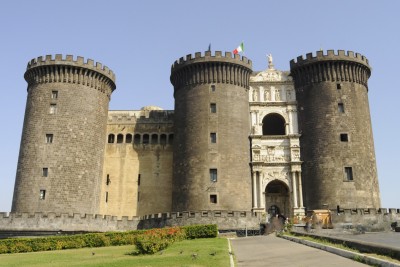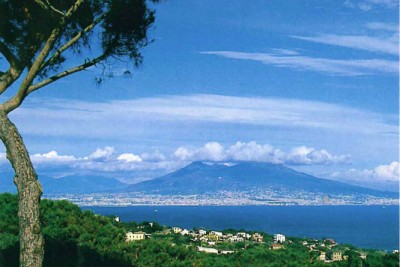Our Insider Guide to the Small Islands Situated in Front of Naples and Above Capri
The beautiful islands of Nisida, Ischia and Procida




For travelers who want to relax after visiting Naples, the three islands of the Bay of Naples - Nisida, Procida and Ischia - are ideal for a long weekend.
Nisida
A volcanic islet part of the Flegrean Islands archipelago, Nisida is just a few miles off the tip of Cape Posillipo, North of Naples. Its name comes from the Greek for "islet" (small island), for which the Latinized accusative was Nesida.

Almost circular, with a flooded crater forming the bay of Porto Paone (#1 on the map) on the southwest coast, it is connected to the mainland by a stone bridge.

Lucius Licinius Lucullus and Marcus Iunius Brutus had their villas there. Cicero's letters record him visiting Brutus there, and it was in that island that Brutus's wife Porcia, the daughter of Cato Uticensis, committed suicide. In fact, some claim that some of archaeological remains on Nisida are, indeed, those of the villa of Brutus.
In the 19th century, Nisida was the site of an infamous prison that gained notoriety when William Ewart Gladstone wrote his Two Letters to the Earl of Aberdeen on the State Prosecutions of the Neapolitan Government, exposing its harsh conditions. In those letters, Gladstone coined the now famous description of the Kingdom of Two Sicilies as "the negation of God erected into a system of Government."
During the World War II, the island was occupied by British Army and again used as a prison facility.
The connections between the island and Britain may begin in the 7th century with Hadrian or Adrian of Canterbury, abbot of Christchurch, Canterbury. Bede records that he was a Greek-speaking Berber from North Africa, who was abbot of a monastery near Naples. The name of the monastery varies with different textual traditions between monasterium Niridanum and Hiridanum.
Procida
Procida, the smallest and least known of Neapolitan islands, has kept its Mediterranean identity unaltered and is an ideal destination for those seeking an out-of-the-way holiday, far from the mass tourism routes.
The rich vegetation that acts as backdrop for the Mediterranean architecture, the pristine and splendid sea and the beautiful boulders of the coast, all make for unusual and exciting scenery.
Compared to Ischia and Capri, Procida still today is fascinating for its quiet streets, the vivid colors of the ancient buildings and the villages clinging to the rocks above the little ports. Its name probably derives from the Latin name Prochyta, which comes from Prima Cyme, meaning 'near Cuma'. According to another theory, Prochyta comes from the Greek verb prokeitai, meaning 'it lies forth', because of the appearance of the island seen from the sea.
The Port of Sancio Cattolico, also known as Marina Grande (#1), is where the boats that arrive from Naples and Pozzuoli dock.

The brightly colored houses that face the sea are the first images that welcome the visitor.
This fishing village is dominated by the Castello (#2), or Castle that sits on the top of a sheer cliff overlooking the sea, on the inside of the highest part of the island, Terra Murata, heart of the island.

Castello
The town, which encloses medieval houses with courtyards and gardens, churches, buildings and a castle, has remained more or less intact for three hundred years.

The view of the Belvedere is enchanting while the small port of Corricella (#3) is very characteristic, with its delightful architecture of intricate little houses one upon the other. Its intertwining alleys make it seem like a natural stage setting.

Port of Corricella
Marina di Chiaiolella (#4), a lovely semicircular inlet closed by the old Santa Margherita promontory, is the best place for swimming, while the Procida Lido is much busier with bathers.

Marina di Chiaiolella
Another beach worth visiting is the one at Pozzo Vecchio (#5), seen in scenes from the movie “Il Postino”.

Pozzo Vecchio
A long bridge connects la Chiaiolella with the islet of Vivara (#6), a WWF-protected oasis that can visited only with a permit from the town.
 Vivara
Vivara
Also worth visiting is the Abbazia di San Michele Arcangelo (#7), or Abbey of St. Michael, which had a central role in Procida's religious and cultural history.

Ischia
The largest island in the Gulf of Naples and a very popular destination, Ischia is visited in all seasons, thanks to its particularly mild climate.
Apart from the attraction of its beautiful scenery, due to a breathtaking landscape of valleys, hills, cliffs, woods and beaches, the island is known for its thermal baths.
The thermal wealth of the island is in fact immense: there are 29 basins and hundreds of mineral springs.
Ischia was the first Greek settlement in the Tyrrhenian Sea, founded in the 8th century BC, with the name of Pithekousa (island of the 'pithoi', or clay vases).
The Castello Aragonese (#1), or Aragonese Castle, built by Hiero of Syracuse in 474 B.C. in Ischia Ponte, is the most visited monument on the island.

Castello Aragonese
Once atop, be sure not to miss the Cattedrale di Santa Maria Assunta (#2) where, in 1509, Ferrante d’Avalos and Vittoria Colonna exchanged their vows. Inside is a crypt holding frescoes by the Giotto school painters.
 Santa Maria Assunta
Santa Maria Assunta
The collection of the Museo Archeologico di Pinthacusa (#3), or Archaelogical Museum of Pithecusa, located in Villa Arbusto, includes the famous Coppa di Nestore or Nestor's Cup.
 Museo Archeologico Pithecusae
Museo Archeologico Pithecusae
From the crypt of the nearby Chiesa di Santa Restituita (#4) one enters the excavations of a paleo-Christian basilica. The museum's relics tell the story of the island from the time of the Greeks to the first Christians.
 Santa Restituita
Santa Restituita
Forio holds on to its strong tradition of a much less visited fisherman's village. Here, on a rocky outcrop, the Chiesa di Santa Maria del Soccorso (#5) stands out, with its tradition of local architecture intact.
 Santa Maria del Soccorso
Santa Maria del Soccorso
Sunset here, with the reflected red light of the blazing sun burning the white walls of the church, is a unique experience.
A 5th century tower dominates the center of town and is home to the Museo Civico del Torrione (#6), the local Civic Museum.

The renown beach of Citara (#7) is one of the most beautiful on the island.

Citara, beach
Near Forio is the spectacular garden of Villa La Mortella (#8), home of the composer Sir William Walton.
 La Mortella, garden
La Mortella, garden
On the southern part of the island is Sant'Angelo (#9), a tiny, enchanting former fishing village that became an elegant tourist center.
 Sant'Angelo
Sant'Angelo
Inland you will find Panza (#10) in a lovely panoramic position.
 Panza
Panza
On the hills that descend to the wide beach of Maronti you will find Barano d'lschia (#11).
 Barano d'Ischia
Barano d'Ischia
From Serrara Fontana (#12) you will able to start your excursions to Mount Epomeo.
 View of Sant'Angelo from the Belvedere of Serrara Fontana
View of Sant'Angelo from the Belvedere of Serrara Fontana
Monte Epomeo (#13), or Mount Eponeo, which gives the island its unmistakable shape, dominates the coast below offerings breathtaking views over the Gulf of Naples.
 View from the top of Monte Eponeo
View from the top of Monte Eponeo
Once on the summit, a visit to the 15th century Eremo di San Nicola (#14), or Hermitage of San Nicola, entirely carved into tufa rock, is recommended. The renown beach of Citara is one of the most beautiful on the island.

Eremo di San Nicola
For printing our Neapolitan Islands Guide (facing pages) you can download the PDF by clicking HERE
For offline reading on your smartphone or tablet, you can download the PDF of our Neapolitan Islands Guide (single page) by clicking HERE
If you have an Android OS, you will find it in your Download app.
If you have an iPhone or an iPad, open and save it in iBook (free app).
Watch a video on the three small islands in front of Naples


